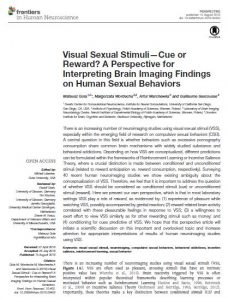Mental Health
Visual Sexual Stimuli—Cue or Reward?
 Full Article Title: Visual Sexual Stimuli—Cue or Reward? A Perspective for Interpreting Brain Imaging Findings on Human Sexual Behaviors
Full Article Title: Visual Sexual Stimuli—Cue or Reward? A Perspective for Interpreting Brain Imaging Findings on Human Sexual Behaviors
Open Access: Yes
Abstract
There is an increasing number of neuroimaging studies using visual sexual stimuli (VSS), especially within the emerging field of research on compulsive sexual behaviors (CSB). A central question in this field is whether behaviors such as excessive pornography consumption share common brain mechanisms with widely studied substance and behavioral addictions. Depending on how VSS are conceptualized, different predictions can be formulated within the frameworks of Reinforcement Learning or Incentive Salience Theory, where a crucial distinction is made between conditioned and unconditioned stimuli (related to reward anticipation vs. reward consumption, respectively). Surveying 40 recent human neuroimaging studies we show existing ambiguity about the conceptualization of VSS. Therefore, we feel that it is important to address the question of whether VSS should be considered as conditioned stimuli (cue) or unconditioned stimuli (reward). Here we present our own perspective, which is that in most laboratory settings VSS play a role of reward, as evidenced by: (1) experience of pleasure while watching VSS, possibly accompanied by genital reaction; (2) reward-related brain activity correlated with these pleasurable feelings in response to VSS; (3) a willingness to exert effort to view VSS similarly as for other rewarding stimuli such as money; and (4) conditioning for cues predictive of VSS. We hope that this perspective article will initiate a scientific discussion on this important and overlooked topic and increase attention for appropriate interpretations of results of human neuroimaging studies using VSS.
Citation
Gola, M., Wordecha, M., Marchewka, A., & Sescousse, G. (2016). Visual sexual stimuli-cue or reward? a perspective for interpreting brain imaging findings on human sexual behaviors. Frontiers in Human Neuroscience, 10, 402–402. https://doi.org/10.3389/fnhum.2016.00402
